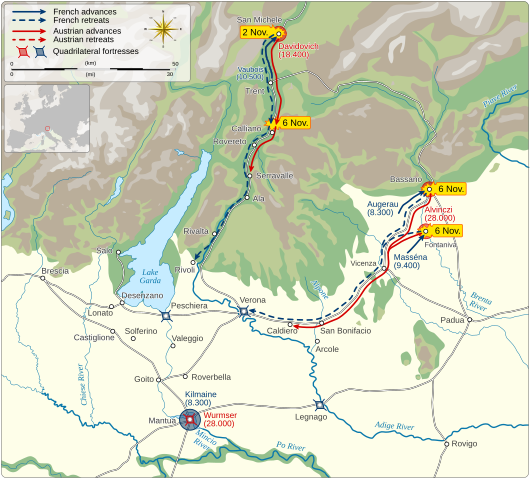Second Battle of Bassano facts for kids
Quick facts for kids Second Battle of Bassano |
|||||||
|---|---|---|---|---|---|---|---|
| Part of French Revolutionary Wars | |||||||
|
|||||||
| Belligerents | |||||||
| Commanders and leaders | |||||||
| Strength | |||||||
| 19,500 infantry | 28,000 infantry | ||||||
| Casualties and losses | |||||||
| 3,000 dead and wounded | 2,800-5,600 dead and wounded 2 guns |
||||||
The Second Battle of Bassano took place on November 6, 1796. It was a major fight between the Austrian army, led by József Alvinczi, and the French army, led by Napoleon Bonaparte. The battle happened near Bassano del Grappa in Northern Italy.
The Austrians successfully defended against many French attacks. Both sides lost many soldiers. This battle was important because it was the first time Napoleon Bonaparte faced a tactical defeat in his career. It was part of the French Revolutionary Wars and aimed to help the city of Mantua, which was under siege by the French.
Contents
Why the Battle Happened: Background
The city of Mantua was under siege by the French army. This battle was part of the third attempt by the Austrians to free Mantua. The previous attempt, in September, ended badly for the Austrians. Napoleon had defeated them at the first Battle of Bassano. After that, the Austrian general, Dagobert Sigismund von Würmser, and his 12,000 soldiers were trapped inside Mantua. Many of them got sick or hurt because the city was so crowded.
The Austrian Emperor, Francis II of Austria, decided to try again. He put General Alvinczi in charge of a new army. Alvinczi and his officers planned a two-part attack. Alvinczi himself led the main army of 28,000 soldiers from the east. Another Austrian force of 19,000 men, led by Paul Davidovich, advanced from the north.
Napoleon had to split his forces to face these two threats. He sent about 10,500 soldiers to the north. He placed 9,500 soldiers at Bassano and 8,300 soldiers at Verona. Another 8,800 soldiers were still blocking Mantua.
How the Battle Unfolded
The Austrian forces began to move in late October. Davidovich's army in the north pushed the French back by November 5. Meanwhile, Alvinczi's main army started crossing the Piave River on November 1. The French general, André Masséna, pulled his troops out of Bassano on November 4. Austrian troops quickly took over the town.
Napoleon decided to attack the Austrians. He ordered his generals to join Masséna to fight Alvinczi near the Brenta River.
Fighting at Fontaniva
Napoleon joined one of his divisions as it moved towards Bassano. Masséna's troops took a different route. They met the Austrian army's left side at Fontaniva on November 5. The Austrians pulled back to the east side of the river. This set the stage for the main battle on November 6.
At 7 a.m., Masséna's French troops attacked the Austrians at Fontaniva. For many hours, the French launched attack after attack. They tried to cross the river up to ten times. Both sides suffered heavy losses. The Austrian soldiers bravely defended the river crossing. They lost many men but held their ground. The Austrian general, Anton Lipthay de Kisfalud, was injured when his horse fell, but he stayed with his soldiers.
Fighting at Bassano
Earlier that morning, the Austrian general Hohenzollern crossed the Brenta River. Other Austrian troops followed him. They set up their lines with one side in the mountains and the other side touching the Brenta River.
Napoleon's troops started arriving in the area later that morning. In the early afternoon, they attacked Bassano. The fighting was very fierce. The village of Nove changed hands many times. The battle continued until 10 p.m. One Austrian battalion lost almost half of its soldiers. Even though Napoleon claimed a victory, he ordered his troops to retreat that evening.
What Happened Next: Results
The French army lost about 3,000 soldiers, including 508 captured. They also lost one howitzer (a type of cannon). The Austrians lost about 2,823 soldiers and two cannons.
After the battle, the French quickly retreated towards Verona. On November 7, the Austrians also defeated another French force in the north. These two defeats put Napoleon in a difficult spot. The two Austrian armies were threatening to surround him. Also, the large Austrian army still trapped in Mantua was behind him.
Alvinczi continued to advance. His troops reached the edge of Verona by November 11. The next day, Napoleon attacked the Austrians again at the Battle of Caldiero, but he was not successful. Napoleon's challenges were far from over. The most important battle of this campaign was the Battle of Arcole, which took place a few days later.
More to Explore
- Siege of Mantua (1796–1797)
- Battle of Calliano, November 7, 1796
- Battle of Caldiero, November 12, 1796
- Battle of Arcole, November 15–17, 1796


